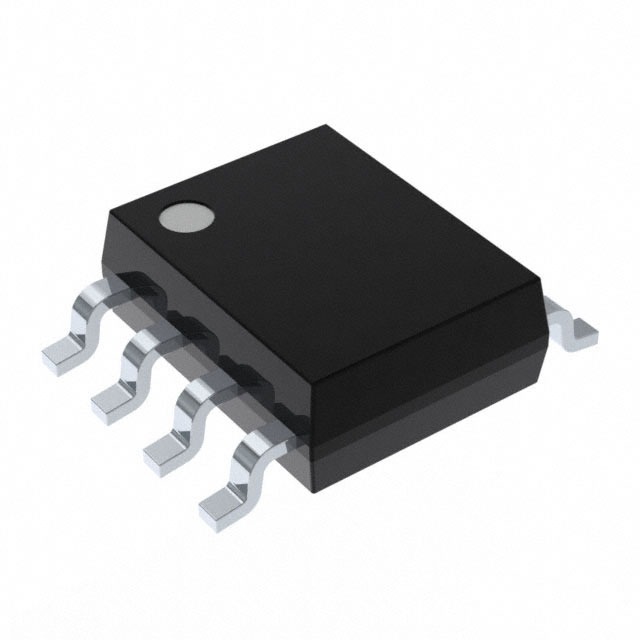Xem thông số kỹ thuật để biết chi tiết sản phẩm.

MAX4461UESA+T
Product Overview
- Category: Integrated Circuit (IC)
- Use: Audio Amplifier
- Characteristics: Low-power, low-noise, single-supply amplifier
- Package: 8-pin µMAX® package
- Essence: Amplifies audio signals with high fidelity and minimal distortion
- Packaging/Quantity: Tape and reel packaging, 2500 units per reel
Specifications
- Supply Voltage Range: 2.7V to 5.5V
- Quiescent Current: 0.6mA
- Gain Bandwidth Product: 1MHz
- Input Noise Voltage: 30nV/√Hz
- Output Drive Capability: 150mW
- Total Harmonic Distortion: 0.01% (typical)
Pin Configuration
The MAX4461UESA+T has the following pin configuration:
___________
| |
NC |1 8| VCC
IN- |2 7| OUT
IN+ |3 6| GND
NC |4 5| NC
|___________|
Functional Features
- Low-power consumption for extended battery life
- Low input noise for improved audio quality
- Single-supply operation simplifies circuit design
- Wide supply voltage range allows flexibility in power source selection
- High gain bandwidth product enables amplification of high-frequency signals
- Small package size saves board space
Advantages and Disadvantages
Advantages: - Low power consumption extends battery life in portable applications. - Low input noise ensures high-quality audio reproduction. - Single-supply operation simplifies circuit design and reduces component count. - Wide supply voltage range allows compatibility with various power sources. - Small package size saves valuable board space.
Disadvantages: - Limited output drive capability may not be suitable for high-power audio applications. - Total harmonic distortion may slightly affect audio fidelity in critical applications.
Working Principles
The MAX4461UESA+T is a low-power, low-noise audio amplifier designed to amplify audio signals with high fidelity and minimal distortion. It operates on a single supply voltage ranging from 2.7V to 5.5V, making it suitable for various portable and battery-powered applications.
The amplifier's input stage consists of a differential pair that provides high common-mode rejection ratio (CMRR) and rejects common-mode noise. The amplified signal is then passed through a gain stage, which can be externally configured using external resistors.
The output stage of the amplifier provides a low impedance drive capable of delivering up to 150mW of power to the load. This allows the MAX4461UESA+T to drive small speakers or headphones directly without the need for additional amplification stages.
Detailed Application Field Plans
The MAX4461UESA+T finds applications in various audio-related fields, including:
- Portable Audio Devices: The low-power consumption and small package size make it ideal for use in portable music players, smartphones, and tablets.
- Hearing Aids: The low-noise characteristics and single-supply operation make it suitable for hearing aid applications, where clear and amplified sound reproduction is crucial.
- Communication Systems: The amplifier can be used in intercom systems, walkie-talkies, and other communication devices to enhance audio quality and improve speech intelligibility.
- Home Entertainment Systems: The MAX4461UESA+T can be utilized in audio receivers, soundbars, and home theater systems to amplify audio signals and deliver immersive sound experiences.
Detailed and Complete Alternative Models
- LM386: A popular audio amplifier IC with similar characteristics and pin configuration.
- TPA3116D2: A high-power audio amplifier IC suitable for driving larger speakers.
- NJM2073: A low-noise, single-supply audio amplifier with a wide supply voltage range.
These alternative models offer similar functionality and can be considered as substitutes for the MAX4461UESA+T based on specific application requirements.
In conclusion, the MAX4461UESA+T is a low-power, low-noise audio amplifier IC that provides high-quality audio amplification in various applications. Its small package size, wide supply voltage range, and low power consumption make it a versatile choice for portable audio devices, hearing aids, communication systems, and home entertainment systems.
Liệt kê 10 câu hỏi và câu trả lời thường gặp liên quan đến ứng dụng MAX4461UESA+T trong giải pháp kỹ thuật
Sure! Here are 10 common questions and answers related to the application of MAX4461UESA+T in technical solutions:
Q1: What is the MAX4461UESA+T? A1: The MAX4461UESA+T is a low-power, single-supply operational amplifier designed for audio applications.
Q2: What is the supply voltage range for the MAX4461UESA+T? A2: The supply voltage range for the MAX4461UESA+T is typically between 2.7V and 5.5V.
Q3: What is the gain bandwidth product of the MAX4461UESA+T? A3: The gain bandwidth product of the MAX4461UESA+T is typically 1MHz.
Q4: Can the MAX4461UESA+T be used in battery-powered applications? A4: Yes, the low-power characteristics of the MAX4461UESA+T make it suitable for battery-powered applications.
Q5: What is the input voltage range of the MAX4461UESA+T? A5: The input voltage range of the MAX4461UESA+T extends from the negative supply rail to the positive supply rail.
Q6: Is the MAX4461UESA+T suitable for audio signal amplification? A6: Yes, the MAX4461UESA+T is specifically designed for audio applications and can be used for signal amplification.
Q7: Does the MAX4461UESA+T have built-in protection features? A7: No, the MAX4461UESA+T does not have built-in protection features. External protection circuitry may be required.
Q8: What is the typical quiescent current consumption of the MAX4461UESA+T? A8: The typical quiescent current consumption of the MAX4461UESA+T is around 500µA.
Q9: Can the MAX4461UESA+T be used in single-supply applications? A9: Yes, the MAX4461UESA+T is designed for single-supply operation and can be used in such applications.
Q10: What is the package type of the MAX4461UESA+T? A10: The MAX4461UESA+T is available in a small SOT23-8 package.
Please note that these answers are general and may vary depending on specific application requirements.

